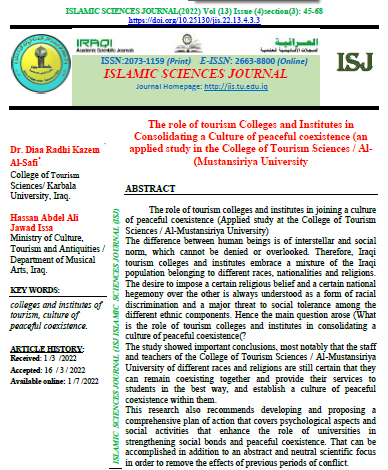The role of tourism Colleges and Institutes in Consolidating a Culture of peaceful coexistence (an applied study in the College of Tourism Sciences / Al-Mustansiriya University)
Main Article Content
Abstract
The role of tourism colleges and institutes in joining a culture of peaceful coexistence (Applied study at the College of Tourism Sciences / Al-Mustansiriya University)
The difference between human beings is of interstellar and social norm, which cannot be denied or overlooked. Therefore, Iraqi tourism colleges and institutes embrace a mixture of the Iraqi population belonging to different races, nationalities and religions. The desire to impose a certain religious belief and a certain national hegemony over the other is always understood as a form of racial discrimination and a major threat to social tolerance among the different ethnic components. Hence the main question arose (What is the role of tourism colleges and institutes in consolidating a culture of peaceful coexistence?)
The study showed important conclusions, most notably that the staff and teachers of the College of Tourism Sciences / Al-Mustansiriya University of different races and religions are still certain that they can remain coexisting together and provide their services to students in the best way, and establish a culture of peaceful coexistence within them.
This research also recommends developing and proposing a comprehensive plan of action that covers psychological aspects and social activities that enhance the role of universities in strengthening social bonds and peaceful coexistence. That can be accomplished in addition to an abstract and neutral scientific focus in order to remove the effects of previous periods of conflict.
Article Details

This work is licensed under a Creative Commons Attribution 4.0 International License.
COLLEGE OF ISLAMIC SCIENCES, TIKRIT UNIVERSITY. THIS IS AN OPEN ACCESS ARTICLE UNDER THE CC BY LICENSE http://creativecommons.org/licenses/by/4.0/

